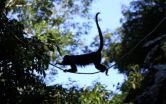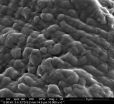(Press-News.org) The innate immune system detects invasive pathogens and activates defense mechanisms to eliminate them. Pathogens, however, employ a variety of tricks to block this process. A new study led by Karl-Peter Hopfner of Ludwig-Maximilians-Universitaet (LMU) in Munich shows how the measles virus thwarts the system, by means of a simple hairpin-like structure.
The innate immune system is the body's first line of defense against invasive pathogens and noxious chemicals. Essentially the system consists of an array of receptors that recognize particular molecular conformations which are characteristic of pathogenic organisms and viruses. Among the classes of molecules bound by these receptors are viral nucleic acids, which are bound specifically by so-called RIG-I-like receptors in the cytoplasm of infected cells. One of these is MDA5, which polymerizes into filaments on long double-stranded RNAs that indicate the presence of RNA viruses. RIG-I itself binds to shorter terminal segments of viral RNAs.
However, viruses have come up with a plethora of ways to avoid triggering immune defense measures. "The virus that causes measles, for instance, produces a so-called V protein, which binds specifically to MDA5 and one other RIG-I-like receptor, and thus impairs recognition of virus-infected cells by the adaptive immune system, although it does not inhibit RIG-I itself," says Professor Karl-Peter Hopfner of LMU's Gene Center. Indeed this kind of competition between viral and cellular proteins largely determines the distribution and - above all - the virulence of viral pathogens.
A hairpin opens up the receptor
"We have been able to crystallize the complex formed by the V protein and MDA5 for the first time, and have determined its three-dimensional structure in detail," Hopfner reports. This structure also permitted Hopfner's team, in collaboration with LMU virologist Professor Karl-Klaus Conzelmann, to clarify the mode of action of the V protein. The analysis revealed that it inserts a hairpin loop into the core secondary structure of MDA5, unfolding the protein and allowing V to bind to a segment that is normally buried in the interior of the molecule. This in turn prevents MDA5 from forming filaments and signaling the presence of viral RNA.
This finding was completely unexpected, and explains why MDA5, but not RIG-I, is inhibited by the V protein: This internal sequence is different in RIG-I and this is the reason why RIG-I is not targeted by the viral product. "Our work provides a detailed insight into the mechanisms viral proteins use to inhibit host protein function. It may also open opportunities for new therapeutic interventions," Hopfner concludes.
###
Protein structure: Immune system foiled by a hairpin
2013-01-22
ELSE PRESS RELEASES FROM THIS DATE:
Monkeys stressed from longer foraging times
2013-01-22
Endangered Mexican howler monkeys are consuming more leaves and less fruit as a result of habitat disturbance by humans, which is forcing them to invest much more time foraging for sustenance and leading to increased 'stress' levels, as detected through hormone analysis.
The research, published today in the International Journal of Primatology, took place in the tropical rainforests of the Mexican state of Veracruz, which are being deforested and fragmented by human activity - primarily the clearing of forest for cattle raising.
It shows that increases in howler monkey ...
Smoke-free law linked to large fall in child asthma hospital admissions
2013-01-22
The introduction of smoke-free legislation in England was immediately followed by a fall in the number of children admitted to hospital with asthma symptoms, a new study has found.
NHS statistics analysed by researchers at Imperial College London show a 12.3 per cent fall in admissions for childhood asthma in the first year after the law on smoking in enclosed public places and workplaces came into effect in July 2007. The researchers found that asthma admissions continued to fall in subsequent years, suggesting that the benefits of the legislation were sustained over ...
Cleaning jobs linked to asthma risk
2013-01-22
A new study has found strong evidence for a link between cleaning jobs and risk of developing asthma.
Researchers at Imperial College London tracked the occurrence of asthma in a group of 9,488 people born in Britain in 1958. Not including those who had asthma as children, nine per cent developed asthma by age 42. Risks in the workplace were responsible for one in six cases of adult onset asthma – even more than the one in nine cases attributed to smoking, according to the analysis.
There are many occupations that are thought to cause asthma. In this study, 18 occupations ...
Cotton with special coating collects water from fogs in desert
2013-01-22
Researchers at Eindhoven University of Technology (TU/e) together with researchers at the Hong Kong Polytechnic University (PolyU), have developed a special treatment for cotton fabric that allows the cotton to absorb exceptional amounts of water from misty air: 340 % of its own weight. What makes this 'coated cotton' so interesting is that the cotton releases the collected water by itself, as it gets warmer. This property makes of the coated cotton materials a potential solution to provide water to the desert regions, for example for agricultural purposes. The results ...
New findings on mortality of individuals with schizophrenia
2013-01-22
A new study from Lund University in Sweden shows that the average life expectancy of men and women with schizophrenia is 15 years and 12 years shorter respectively than for those who do not suffer from the disease. The study has been carried out in collaboration with Stanford University in the US.
The reasons why people with schizophrenia have a shorter life expectancy have previously been unknown, but have been much discussed in recent years. The research report that has now been published shows that individuals with schizophrenia are more likely to die of two major ...
Immune function in critically ill kids with influenza reveals immune suppression in non-survivors
2013-01-22
Investigators from 15 children's medical centers, including Nationwide Children's Hospital, observed and evaluated critically ill children with influenza to evaluate the relationships between levels of systemic inflammation, immune function and likelihood to die from the illness. The study appears in the January issue of Critical Care Medicine.
The innate immune system is the cellular arm of the immune system that serves as a first-responder to new threats, and is thought to drive the inflammatory response in many forms of critical illness. Recent evidence indicates that ...
Human-tiger conflict: Are the risks overestimated?
2013-01-22
Wildlife conservationists are well aware of the potential conflicts that exist between the endangered species they seek to protect and the human populations which inhabit areas where the animals live. Carnivores, such as tigers, pose a risk to humans and their livestock and can be killed because of this potential risk. Previous research has found that killing of animals can be motivated as much by social and psychological factors, such as perception of danger, as by any actual real risk posed by a species.
A new study published in the Springer journal Human Ecology ...
Mama bear knows best, University of Alberta study shows
2013-01-22
Mama bear appears to know best when it comes to selecting a place to call home, according to a new University of Alberta study.
The study, published in the latest issue of PLOS ONE, explored whether the rearing of cubs by their mothers shaped which habitats grizzly bears eventually choose.
The findings "suggest that habitat selection is learned by young grizzly bears from their mothers, and would likely be a more adaptive strategy than using instinct," said lead author Scott Nielsen, assistant professor in the U of A Department of Renewable Resources.
The University ...
New evidence indicates auroras occur outside our solar system
2013-01-22
University of Leicester planetary scientists have found new evidence suggesting auroras – similar to Earth's Aurora Borealis - occur on bodies outside our solar system.
Auroras occur on several planets within our solar system, and the brightest - on Jupiter – are 100 times brighter than those on Earth. However, no auroras have yet been observed beyond Neptune.
A new study led by University of Leicester lecturer Dr Jonathan Nichols has shown that processes strikingly similar to those which power Jupiter's auroras could be responsible for radio emissions detected from ...
Penn study sheds light on the complexity of gene therapy for congenital blindness
2013-01-22
PHILADELPHIA - Independent clinical trials, including one conducted at the Scheie Eye Institute at the Perelman School of Medicine, have reported safety and efficacy for Leber congenital amaurosis (LCA), a congenital form of blindness caused by mutations in a gene (RPE65) required for recycling vitamin A in the retina. Inherited retinal degenerative diseases were previously considered untreatable and incurable. There were early improvements in vision observed in the trials, but a key question about the long-term efficacy of gene therapy for curing the retinal degeneration ...


